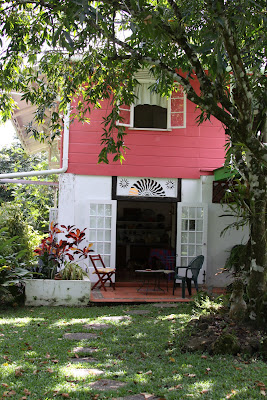Bunty works out of her literal pottery barn. It is at once a quiet and serene place but it is also a place of activity with the presence of the big kilns in the background. The BBC radio rumbles along in the background while everyone works quietly.
 On one of the work tables lie two large cannon ball fruit. Bunty is trying to propogate the cannon ball tree by seed. Because this is another passion; the propagation of trees. A large jacaranda tree guards the entrance to the barn and everywhere one looks there are large trees.
On one of the work tables lie two large cannon ball fruit. Bunty is trying to propogate the cannon ball tree by seed. Because this is another passion; the propagation of trees. A large jacaranda tree guards the entrance to the barn and everywhere one looks there are large trees.

 Bunty's own work change from show to show as her upcoming ouvre will illustrate. Visiting a Bunty show is always a joy because you can see where she has explored new territory. The work is never the same.
Bunty's own work change from show to show as her upcoming ouvre will illustrate. Visiting a Bunty show is always a joy because you can see where she has explored new territory. The work is never the same.  To walk in the garden is a privilege. Bunty is doing tremendous work with seed collecting and propogation of indigenous trees. The family hikes regularly and much of her inspiration and creative spirit comes from this close connection with her landscape. She is surrounded by five acres of slightly undulating land that looks northwards up to the northern range and throws a backward glance to Tamana in the central range.
To walk in the garden is a privilege. Bunty is doing tremendous work with seed collecting and propogation of indigenous trees. The family hikes regularly and much of her inspiration and creative spirit comes from this close connection with her landscape. She is surrounded by five acres of slightly undulating land that looks northwards up to the northern range and throws a backward glance to Tamana in the central range.  And Rory, kiln engineer extraordinaire.
And Rory, kiln engineer extraordinaire. The patio that opens out onto the garden and which can be populated at any time with chickens, cats, dogs, grandchildren or an assorted mix of the above.
The patio that opens out onto the garden and which can be populated at any time with chickens, cats, dogs, grandchildren or an assorted mix of the above. A calathea flower that I came across in Bunty's garden. Being sorrounded by such tropical abundance must have an impact on the creative process and Bunty's determination to channel this process and follow the artistic impulse represents the best of our spirit here in Trinidad.
A calathea flower that I came across in Bunty's garden. Being sorrounded by such tropical abundance must have an impact on the creative process and Bunty's determination to channel this process and follow the artistic impulse represents the best of our spirit here in Trinidad. And as if organic eggs were not impressive enough, here are her fresh healthy lettuce. YUM!
And as if organic eggs were not impressive enough, here are her fresh healthy lettuce. YUM!














 Just around the same time the dinosaurs disappeared. The shell's unusual colouration is found only in ammonites from Alberta, Canada and is a result of millions of years of high temperatures and pressures which account for the iridescent effect.
Just around the same time the dinosaurs disappeared. The shell's unusual colouration is found only in ammonites from Alberta, Canada and is a result of millions of years of high temperatures and pressures which account for the iridescent effect. 







